
- Bioactive Compounds
- By Signaling Pathways
- PI3K/Akt/mTOR
- Epigenetics
- Methylation
- Immunology & Inflammation
- Protein Tyrosine Kinase
- Angiogenesis
- Apoptosis
- Autophagy
- ER stress & UPR
- JAK/STAT
- MAPK
- Cytoskeletal Signaling
- Cell Cycle
- TGF-beta/Smad
- Compound Libraries
- Popular Compound Libraries
- Customize Library
- Clinical and FDA-approved Related
- Bioactive Compound Libraries
- Inhibitor Related
- Natural Product Related
- Metabolism Related
- Cell Death Related
- By Signaling Pathway
- By Disease
- Anti-infection and Antiviral Related
- Neuronal and Immunology Related
- Fragment and Covalent Related
- FDA-approved Drug Library
- FDA-approved & Passed Phase I Drug Library
- Preclinical/Clinical Compound Library
- Bioactive Compound Library-I
- Bioactive Compound Library-II
- Kinase Inhibitor Library
- Express-Pick Library
- Natural Product Library
- Human Endogenous Metabolite Compound Library
- Alkaloid Compound LibraryNew
- Angiogenesis Related compound Library
- Anti-Aging Compound Library
- Anti-alzheimer Disease Compound Library
- Antibiotics compound Library
- Anti-cancer Compound Library
- Anti-cancer Compound Library-Ⅱ
- Anti-cancer Metabolism Compound Library
- Anti-Cardiovascular Disease Compound Library
- Anti-diabetic Compound Library
- Anti-infection Compound Library
- Antioxidant Compound Library
- Anti-parasitic Compound Library
- Antiviral Compound Library
- Apoptosis Compound Library
- Autophagy Compound Library
- Calcium Channel Blocker LibraryNew
- Cambridge Cancer Compound Library
- Carbohydrate Metabolism Compound LibraryNew
- Cell Cycle compound library
- CNS-Penetrant Compound Library
- Covalent Inhibitor Library
- Cytokine Inhibitor LibraryNew
- Cytoskeletal Signaling Pathway Compound Library
- DNA Damage/DNA Repair compound Library
- Drug-like Compound Library
- Endoplasmic Reticulum Stress Compound Library
- Epigenetics Compound Library
- Exosome Secretion Related Compound LibraryNew
- FDA-approved Anticancer Drug LibraryNew
- Ferroptosis Compound Library
- Flavonoid Compound Library
- Fragment Library
- Glutamine Metabolism Compound Library
- Glycolysis Compound Library
- GPCR Compound Library
- Gut Microbial Metabolite Library
- HIF-1 Signaling Pathway Compound Library
- Highly Selective Inhibitor Library
- Histone modification compound library
- HTS Library for Drug Discovery
- Human Hormone Related Compound LibraryNew
- Human Transcription Factor Compound LibraryNew
- Immunology/Inflammation Compound Library
- Inhibitor Library
- Ion Channel Ligand Library
- JAK/STAT compound library
- Lipid Metabolism Compound LibraryNew
- Macrocyclic Compound Library
- MAPK Inhibitor Library
- Medicine Food Homology Compound Library
- Metabolism Compound Library
- Methylation Compound Library
- Mouse Metabolite Compound LibraryNew
- Natural Organic Compound Library
- Neuronal Signaling Compound Library
- NF-κB Signaling Compound Library
- Nucleoside Analogue Library
- Obesity Compound Library
- Oxidative Stress Compound LibraryNew
- Plant Extract Library
- Phenotypic Screening Library
- PI3K/Akt Inhibitor Library
- Protease Inhibitor Library
- Protein-protein Interaction Inhibitor Library
- Pyroptosis Compound Library
- Small Molecule Immuno-Oncology Compound Library
- Mitochondria-Targeted Compound LibraryNew
- Stem Cell Differentiation Compound LibraryNew
- Stem Cell Signaling Compound Library
- Natural Phenol Compound LibraryNew
- Natural Terpenoid Compound LibraryNew
- TGF-beta/Smad compound library
- Traditional Chinese Medicine Library
- Tyrosine Kinase Inhibitor Library
- Ubiquitination Compound Library
-
Cherry Picking
You can personalize your library with chemicals from within Selleck's inventory. Build the right library for your research endeavors by choosing from compounds in all of our available libraries.
Please contact us at [email protected] to customize your library.
You could select:
- Antibodies
- Bioreagents
- qPCR
- 2x SYBR Green qPCR Master Mix
- 2x SYBR Green qPCR Master Mix(Low ROX)
- 2x SYBR Green qPCR Master Mix(High ROX)
- Protein Assay
- Protein A/G Magnetic Beads for IP
- Anti-DYKDDDDK Tag magnetic beads
- Anti-DYKDDDDK Tag Affinity Gel
- Anti-Myc magnetic beads
- Anti-HA magnetic beads
- Poly DYKDDDDK Tag Peptide lyophilized powder
- Protease Inhibitor Cocktail
- Protease Inhibitor Cocktail (EDTA-Free, 100X in DMSO)
- Phosphatase Inhibitor Cocktail (2 Tubes, 100X)
- Cell Biology
- Cell Counting Kit-8 (CCK-8)
- Animal Experiment
- Mouse Direct PCR Kit (For Genotyping)
- New Products
- Contact Us
ROS
ROS Products
- All (70)
- ROS Inhibitors (27)
- ROS Activators (19)
- ROS Modulators (6)
- New ROS Products
| Catalog No. | Product Name | Information | Product Use Citations | Product Validations |
|---|---|---|---|---|
| S1623 | Acetylcysteine (N-acetylcysteine) | Acetylcysteine (N-acetyl-l-cysteine, NAC,N-acetylcysteine) is a ROS(reactive oxygen species) inhibitor that antagonizes the activity of proteasome inhibitors. It is also a tumor necrosis factor production inhibitor. Acetylcysteine(N-acetyl-l-cysteine) suppresses TNF-induced NF-κB activation through inhibition of IκB kinases. Acetylcysteine(N-acetyl-l-cysteine) induces apoptosis via the mitochondria-dependent pathway. Acetylcysteine(N-acetyl-l-cysteine) inhibits ferroptosis and virus replication.Solutions are unstable and should be fresh-prepared. |
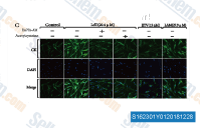
|
|
| S1046 | Vandetanib | Vandetanib is a potent inhibitor of VEGFR2 with IC50 of 40 nM in a cell-free assay. It also inhibits VEGFR3 and EGFR with IC50 of 110 nM and 500 nM, respectively. Not sensitive to PDGFRβ, Flt1, Tie-2 and FGFR1 with IC50 of 1.1-3.6 μM. No activity against MEK, CDK2, c-Kit, erbB2, FAK, PDK1, Akt and IGF-1R with IC50 above 10 μM. Vandetanib (ZD6474) increases apoptosis and induces autophagy by increasing the level of reactive oxygen species (ROS). |
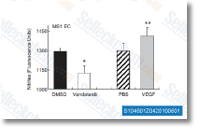
|
|
| S7171 | Setanaxib (GKT137831) | Setanaxib (GKT137831, GKT831) is a potent, dual NADPH oxidase NOX1/NOX4 inhibitor with Ki of 110 nM and 140 nM, respectively. Treatment with GKT137831 suppresses reactive oxygen species (ROS) production. GKT137831 partly inhibits ferroptosis. |
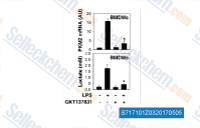
|
|
| S2843 | BI-D1870 | BI-D1870 is an ATP-competitive inhibitor of S6 ribosome for RSK1/2/3/4 with IC50 of 31 nM/24 nM/18 nM/15 nM in cell-free assays, respectively; 10- to 100-fold selectivity for RSK than MST2, GSK-3β, MARK3, CK1 and Aurora B. BI-D1870 exhibits anticancer attributes including the generation of reactive oxygen species (ROS) and increases in endoplasmic reticulum (ER) stress and autophagy. |
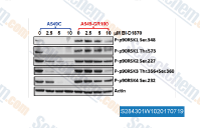
|
|
| S7309 | BAY 87-2243 | BAY 87-2243 is a potent and selective hypoxia-inducible factor-1 (HIF-1) inhibitor. BAY 87-2243 inhibits mitochondrial complex I activity, thus triggering a mitophagy-dependent ROS increase leading to necroptosis and ferroptosis. BAY 87-2243 exerts antitumor activity. Phase 1. |
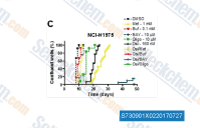
|
|
| S8639 | DPI (Diphenyleneiodonium chloride) | DPI (Diphenyleneiodonium chloride) is an inhibitor of NADPH oxidase and also a potent, irreversible, and time-, temperature-dependent iNOS/eNOS inhibitor. Diphenyleneiodonium chloride (DPI) also functions as a TRPA1 activator and selectively inhibits intracellular reactive oxygen species (ROS). | ||
| S8661 | CA3 (CIL56) | CA3 (CIL56) has potent inhibitory effects on YAP1/Tead transcriptional activity and primarily targets YAP1 high and therapy-resistant esophageal adenocarcinoma cells endowed with CSC properties. CA3(CIL56) induces ferroptosis and iron-dependent reactive oxygen species (ROS). | ||
| S7551 | Piperlongumine | Piperlongumine (PPLGM, Piplartine), a natural alkaloid from Piper longum L., increases the level of reactive oxygen species (ROS) and selectively kills cancer cells. It is a direct TrxR1 inhibitor with suppressive activity against gastric cancer and a novel inhibitor of CRM1; also an inhibitor of PI3K/Akt/mTOR in human breast cancer cells. |
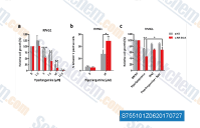
|
|
| S1630 | Allopurinol | Allopurinol is a purine analog inhibitor of the enzyme xanthine oxidase, used to treat gout or kidney stones, and to decrease levels of uric acid. | ||
| S8978 | MitoQ (Mitoquinone) mesylate | MitoQ (Mitoquinone) mesylate is a TPP-based, mitochondria-targeted antioxidant that blocks H2O2-induced intracellular ROS responses and protects against oxidative damage. This product is a waxy solid. | ||
| S8615 | DCA (Sodium dichloroacetate) | DCA (Sodium dichloroacetate), a specific inhibitor of pyruvate dehydrogenase kinase (PDK) with IC50 values of 183 and 80 μM for PDK2 and PDK4 respectively, has been shown to derepress Na+-K+-2Cl- cotransporter and a mitochondrial potassium-ion channel axis. Sodium dichloroacetate increases reactive oxygen species (ROS) generation, triggers apoptosis in cancer cells, and inhibits tumor growth. | ||
| S5804 | N-Acetylcysteine amide | N-acetylcysteine amide is a membrane penetrating antioxidant with anti-inflamatory activity through regulation of activation of NF-κB and HIF-1α as well as modulation of ROS. | ||
| S9687 | H2DCFDA (DCFH-DA) | H2DCFDA (DCFH-DA) is a cell-permeable probe used to detect intracellular reactive oxygen species (ROS) production. It is de-esterified intracellularly and turns to highly fluorescent 2′,7′-dichlorofluorescein upon oxidation. It is used in sensitive and rapid quantitation of oxygen-reactive species in response to oxidative metabolism; microplate assay for detecting oxidative products in phagocytic cells, and quantitative multiwell myeloid differentiation assay.(Ex/Em=488/525 nm) | ||
| S2399 | Dihydromyricetin | Dihydromyricetin (Ampelopsin, Ampeloptin) is a natural antioxidant flavonoid from Ampelopsis grossedentata. |
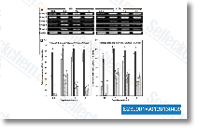
|
|
| S7873 | Disodium (R)-2-Hydroxyglutarate | Disodium (R)-2-Hydroxyglutarate (D-α-Hydroxyglutaric acid disodium) is a competitive inhibitor of α-ketoglutarate-dependent dioxygenases with Ki of 10.87 ± 1.85 mM. | ||
| S1547 | Febuxostat | Febuxostat (TMX 67, TEI-6720) is a selective xanthine oxidase inhibitor with Ki of 0.6 nM. |
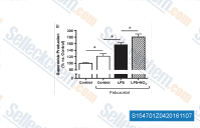
|
|
| S6871 | Sodium oxamate | Sodium oxamate (SO, Aminooxoacetic acid, Oxamic acid) is an inhibitor of lactate dehydrogenase (LDH) that specificly inhibits LDH‑A. Sodium oxamate (SO) induces G2/M cell cycle arrest via downregulation of the CDK1/cyclin B1 pathway and promotes apoptosis through enhancement of mitochondrial ROS generation. | ||
| S1631 | Allopurinol Sodium | Allopurinol Sodium is a xanthine oxidase inhibitor with an IC50 of 7.82±0.12 μM. | ||
| S2332 | Neohesperidin | Neohesperidin (NSC 31048), a flavanone glycoside found in citrus fruits, is an antioxidant agent. | ||
| S8974 | GSK2795039 | GSK2795039 is an inhibitor of NADPH oxidase 2 (NOX2) with pIC50 of 6.57 for NOX2-mediated activation of HRP/Amplex Red. GSK2795039 inhibits reactive oxygen species (ROS) production, NADPH consumption and reduces apoptosis. | ||
| S3838 | Carnosic acid | Carnosic acid (Salvin) is a phenolic diterpene, endowed with antioxidative and antimicrobial properties. It is increasingly used within food, nutritional health and cosmetics industries. | ||
| S4603 | Gallic acid | Gallic acid (3,4,5-Trihydroxybenzoic acid, Gallate, Benzoic acid), known as powerful antioxidants, is an organic acid found in a variety of foods and herbs. | ||
| S9021 | (20R)Ginsenoside Rg3 | (20R)Ginsenoside Rg3 is extracted from traditional Chinese medicine, red ginseng. It has a role as an antioxidant and a plant metabolite. | ||
| S3885 | Pyrogallol | Pyrogallol (1,2,3-trihydroxybenzene), an organic compound belonging to the phenol family, used as a photographic film developer and in the preparation of other chemicals. It is known to be a superoxide anion generator and ROS inducer. | ||
| S2605 | Idebenone | Idebenone (CV-2619) is a synthetic analog of coenzyme Q10 (CoQ10) and a brain stimulant. | ||
| S5452 | Sanguinarine chloride | Sanguinarine, a plant alkaloid, is a potent and specific protein phosphatase (PP) 2C inhibitor. Sanguinarine chloride can stimulate apoptosis via activating the production of reactive oxygen species (ROS). Sanguinarine-induced apoptosis is associated with the activation of JNK and NF-κB. | ||
| S4580 | Hydroquinone | Hydroquinone (Quinol, 1,4-Benzenediol, 1,4-Dihydroxybenzene, HQ) is a Melanin Synthesis Inhibitor. The physiologic effect of hydroquinone is by means of Depigmenting Activity. It also posesses antioxidant properties that can cause toxicity in several organs, notably the kidney.This product is a hazardous chemical (acute toxicity/flammable/skin corrosive). Please use it while wearing a protective face mask, gloves, and clothing. | ||
| S3631 | (S)-Methylisothiourea sulfate | (S)-Methylisothiourea sulfate is a potent inhibitor of inducible NO synthase (iNOS). | ||
| S3616 | Asiaticoside | Asiaticoside (Ba 2742, BRN0078195, CCRIS8995, NSC166062, Emdecassol,Madecassol), the major active principle of Centella asiatica, prevents ultraviolet A-dependent photoaging by suppressing ultraviolet A-induced reactive oxygen species production. It also decreases DNA binding by MITF. | ||
| S3238 | Resibufogenin | Resibufogenin (Bufogenin, Recibufogenin), a component of huachansu with anticancer effect, triggers necroptosis through upregulating receptor-interacting protein kinase 3 (RIP3) and phosphorylating mixed lineage kinase domain-like protein at Ser358. Resibufogenin exerts cytotoxic effect by inducing reactive oxygen species (ROS) accumulation. Resibufogenin induces apoptosis and caspase-3 and caspase-8 activity. Resibufogenin increases Bax/Bcl-2 expression, and suppresses cyclin D1, cyclin E, PI3K, p-AKT, p-GSK3β and β-catenin protein expression. | ||
| S6281 | Sodium Thiocyanate | Sodium Thiocyanate (NaSCN, Sodium rhodanide, Sodium sulfocyanate, Sodium rhodanate), one of the main sources of the thiocyanate anion, is used as a precursor for the synthesis of pharmaceuticals and other specialty chemicals. Sodium thiocyanate (NaSCN) reduces IL-6, whereas increases IL-10 levels. Sodium thiocyanate also reduces ROS. | ||
| S3607 | Sarsasapogenin | Sarsasapogenin (SAR, Parigenin) is a steroidal sapogenin. It can provoke the generation of reactive oxygen species and activate unfolded protein response (UPR) signaling pathways. SAR potently inhibits NF-κB and MAPK activation, as well as IRAK1, TAK1, and IκBα phosphorylation in LPS-stimulated macrophages. | ||
| S2369 | Troxerutin | Troxerutin, a natural bioflavonoid isolated from Sophora japonica, has been reported to have many benefits and medicinal properties. Troxerutin, also known as vitamin P4, is a tri-hydroxyethylated derivative of natural bioflavonoid rutins which can inhibit the production of reactive oxygen species (ROS) and depress ER stress-mediated NOD activation. | ||
| S2062 | Tiopronin | Tiopronin is an antioxidant agent, used for the treatment of cystinuria by controlling the rate of cystine precipitation and excretion. | ||
| S3222 | Raspberry ketone glucoside | Raspberry ketone glucoside (RKG), a natural product in raspberry fruit, is an antioxidant that has the inhibitory effect on the melanin synthesis. | ||
| E8271New | Sanguinarine citrate | Sanguinarine (gluconate) is a benzophenanthridine alkaloid derived from the root of Sanguinaria canadensis. It activates reactive oxygen species (ROS), c-Jun N-terminal kinase (JNK), and nuclear factor-kappaB (NF-κB) signaling pathways to induce apoptosis in head and neck tumor cells and animal models. It also exhibits potent anti-bacterial and anti-inflammatory activities. | ||
| S7913 | MCB-613 | MCB-613 is a potent steroid receptor coactivator (SRC) stimulator. | ||
| S4017 | Allylthiourea | Allylthiourea is a metabolic inhibitor that selective inhibits ammonia oxidation. | ||
| S3590 | Triolein | Triolein is an inhibitor of metalloproteinase-1 (MMP-1) and reduces both the expression of IL-6 and ROS generation in irradiated keratinocytes. | ||
| S3301 | Cynarin | Cynarin (Cynarine) is an artichoke phytochemical that possesses a variety of pharmacological features including free-radical scavenging, antioxidant, antihistamic and antiviral activities. Cynarin blocks the interaction between the CD28 of T-cell receptor and CD80 of antigen presenting cells. Cynarin triggers Nrf2 nuclear translocation, restores the balance of glutathione (GSH) and reactive oxygen species (ROS), and inhibits mitochondrial depolarization. | ||
| S4853 | Ecabet sodium | Ecabet sodium (TA-2711, TA-2711E) is a widely employed mucoprotective agent for the treatment of gastric ulcers. Ecabet sodium inhibits the ability of Helicobacter pylori to induce neutrophil production of reactive oxygen species and interleukin-8, Ecabet sodium can also reduce apoptosis. | ||
| S0947 | Cafestol | Cafestol is a natural diterpenes extracted from coffee beans. Cafestol induces apoptosis and regulates a variety of inflammatory mediators to reduce inflammation. Cafestol inhibits PI3K/Akt pathway. Cafestol also can reduce the production of ROS in the leukemia cell line HL60. | ||
| S3816 | Dehydroevodiamine | Dehydroevodiamine (DHED), a constituent of Evodia rutaecarpa, has various biological effects such as hypotensive, negative chronotropic, ion channel depressant, inhibition of nitric oxide production and cerebral blood flow enhancing activities. Dehydroevodiamine inhibits LPS-induced iNOS, COX-2, prostaglandin E2 (PGE2) and nuclear factor-kappa B (NF-κB) expression in murine macrophage cells. | ||
| S4970 | Nerol | Nerol (Cis-Geraniol, Neryl alcohol) is a monoterpene found in many essential oils such as lemongrass and hops. Nerol has antifungal activity, Nerol can trigger mitochondrial dysfunction and disruption via elevation of Ca2+ and ROS leading to apoptosis. | ||
| S5709 | Norgestrel | Norgestrel (WY-3707, SH-70850, SH-850, FH 122-A) is synthetic steroidal progestin that is used in combination with ethinyl estradiol for oral contraception. It also has strong neuroprotective activity. | ||
| E1508New | APG-2449 | APG-2449 is an orally active inhibitor of ALK/ROS1/FAK. APG-2449 exerts potent and durable antitumor activity in human non-small-cell lung cancer (NSCLC) and ovarian tumor models. | ||
| S5314 | HTHQ (1-O-Hexyl-2,3,5-trimethylhydroquinone) | HTHQ (1-O-Hexyl-2,3,5-trimethylhydroquinone), which is a hydroquinone monoalkylether, is a potent anti-oxidative and anti-lipid-peroxidative agent. HTHQ(1-O-Hexyl-2,3,5-trimethylhydroquinone) has considerable anti-oxidative activity by directly reacting with reactive oxygen species (ROS), including peroxyl radicals, and scavenging them to form more stable free radicals. | ||
| S0056 | (E/Z)-BCI | (E/Z)-BCI (BCI, NSC 150117) is an inhibitor of dual specific phosphatase 1/6 (DUSP1/DUSP6) and mitogen-activated protein kinase with EC50 of 13.3 μM and 8.0 μM for DUSP6 and DUSP1 in cells, respectively. (E)-BCI induces apoptosis via generation of reactive oxygen species (ROS) and activation of intrinsic mitochondrial pathway in H1299 lung cancer cells. | ||
| E1961New | NVL-655 | NVL-655 is a selective inhibitor of anaplastic lymphoma kinase (ALK), with potential antineoplastic activity in the Ba/F3 xenograft model. It also exhibits significant inhibitory activity against ROS1, LTK, PYK2, TRKB, and FAK, with an IC50 ≤10-fold ALK and demonstrates high potency against specific ALK mutations, with an IC50 of <0.73 nM, 7 nM, 3 nM, 3 nM for G1202R, G1202R/L1196M, G1202R/G1269A and G1202R/L1198F respectively. | ||
| S0770 | Camalexin | Camalexin, a phytoalexin isolated from Camelina sativa and Arabidopsis (Cruciferae), can induce reactive oxygen species (ROS) production. Camalexin has antibacterial, antifungal, antiproliferative and anticancer activities. | ||
| S5263 | Pyrroloquinoline Quinone Disodium Salt | Pyrroloquinoline quinone (methoxatin disodium salt), an aromatic tricyclic o-quinone, is a redox cofactor for bacterial dehydrogenases. It is an efficient electron transfer catalyst from a number of organic substrates to molecular oxygen (O2), constructing quinoprotein model reactions. | ||
| S3840 | Baohuoside I | Baohuoside I (Icariside II) is a flavonoid isolated from Epimedium koreanum Nakai with anti-inflammatory and anti-cancer activities. It may exert cytotoxic effect via the ROS/MAPK pathway. | ||
| S5771 | Sulforaphane | Sulforaphane is a naturally occurring isothiocyanate derived from the consumption of cruciferous vegetables, such as broccoli, cabbage, and kale. It is an inducer of Nrf2. Sulforaphane is also an inhibitor of histone deacetylase (HDAC) and NF-κB. Sulforaphane increases heme oxygenase-1 (HO-1) and reduces the levels of reactive oxygen species (ROS). Sulforaphane induces cell cycle arrest and apoptosis., | ||
| S2271 | Berberine chloride | Berberine chloride is a quaternary ammonium salt from the group of isoquinoline alkaloids. Berberine activates caspase 3 and caspase 8, cleavage of poly ADP-ribose polymerase (PARP) and the release of cytochrome c. Berberine chloride decreases the expression of c-IAP1, Bcl-2 and Bcl-XL. Berberine chloride induces apoptosis with sustained phosphorylation of JNK and p38 MAPK, as well as generation of the ROS. Berberine chloride is a dual topoisomerase I and II inhibitor. Berberine chloride is also a potential autophagy modulator. | ||
| S3973 | L-SelenoMethionine | L-SelenoMethionine (SeMet), a naturally occurring amino acid, is a major food-form of selenium. It has been used as a supplement, and exhibits some important functions like cancer prevention and antioxidative defense. | ||
| S6920 | SEA0400 | SEA0400 is a selective and potent inhibitor of the Na+-Ca2+ exchanger (NCX) that inhibits Na+-dependent Ca2+ uptake in cultured neurons, astrocytes, and microglia with IC50 of 33 nM, 5.0 nM and 8.3 nM, respectively. SEA0400 prevents sodium nitroprusside (SNP) from increasing ERK and p38 MAPK phosphorylation and production of reactive oxygen species (ROS) in an extracellular Ca(2+)-dependent manner. | ||
| S9034 | Isochlorogenic acid C | Isochlorogenic acid C (3,4-Dicaffeoylquinic acid; 4,5-Dicaffeoylquinic acid), which is a di-O-caffeoyl derivative of chlorogenic acid, is a well-known antioxidant from herbal plants and shows anti-viral effects against EV71. | ||
| S4263 | Efaproxiral Sodium | Efaproxiral Sodium(RSR13 Sodium) is a synthetic allosteric modifier of hemoglobin, decreases Hb-oxygen (O2) binding affinity and enhances oxygenation of hypoxic tumours during radiation therapy. Efaproxiral Sodium is used for brain metastases originating from breast cancer. | ||
| S3357 | Elaidic acid | Elaidic acid is a major trans fatty acid that inhibits cell viability, elevates cell apoptosis by enhancing oxidative stress. Elaidic acid can be used as a pharmaceutical solvent. |
||
| E3399 | Kelp Extract | Kelp Extract is extrcated from Laminariales, which can reduce the generation of endogenous reactive oxygen species. | ||
| S9107 | Glycitein | Glycitein is an aglycone isoflavone found in soy and red clover and exhibits a wide variety of beneficial properties, including neuroprotective, antioxidative, anticancer, anti-osteoporotic, and anti-atherosclerotic activities. | ||
| S9611 | ABTL-0812 | ABTL0812 (α-Hydroxylinoleic acid, LP-10218, SCLN-0812) inhibits Akt/mTOR axis by inducing the overexpression of TRIB3 and activating autophagy in lung squamous carcinoma cell lines. ABTL0812 also induces AMPK activation and ROS accumulation. | ||
| S4511 | 6-Benzylaminopurine | 6-Benzylaminopurine is a first-generation synthetic cytokinin which could regulate the activities of the antioxidant defense system of plants.Its treatment elicits plant growth and development. | ||
| S5584 | Citronellol | Citronellol (Dihydrogeraniol, (±)-β-Citronellol), a constituent of rose and geranium oils, is used in perfumes and insect repellents. Citronellol can cause necrotic apoptosis of NCI-H1299 cells by up-regulating TNF-α, RIP1 / RIP3 activities, and down-regulating caspase-3 / caspase-8 activities. Citronellol also results in a biphasic increase in ROS production at 1 h and at 12 h in NCI-H1299 cells. | ||
| E7174New | D-α-Tocopherol Succinate | D-α-tocopherol succinate (Vitamin E succinate) is an antioxidant tocopherol and a salt form of vitamin E that significantly reduces the cisplatin-induced increase of ROS and decreases cellular necrosis and late apoptosis, thereby inhibiting cisplatin-induced cytotoxicity in HEIOC1 cells. It also exhibits an anti-apoptotic effect. | ||
| S4419 | Ensulizole | Ensulizole (PBSA), a water soluble sunscreen ingredient, is a sulfonated UV absorber which is characterized by intense UVB and partial UVA absorption. Ensulizole can damage the DNA through the generation of reactive oxygen species (ROS) upon UV or sunlight irradiation. | ||
| S4425 | Rifamycin S | Rifamycin S, a quinone and an antibiotic against Gram-positive bacteria (including MRSA), is a clinical drug used to treat tuberculosis and leprosy. Rifamycin S generates reactive oxygen species (ROS) and inhibits microsomal lipid peroxidation. | ||
| E3495 | Oyster Peptide | Oyster peptide enhances the function of the pituitary gonad axis and lowers ROS generation. | ||
| S3578 | Pyrroloquinoline quinone | Pyrroloquinoline quinone (PQQ, Methoxatin) is a natural anti-oxidant with anti-oxidative and anti-aging effects. Pyrroloquinoline quinone prevents estrogen deficiency-induced osteoporosis.Pyrroloquinoline quinone can alleviate allergic airway inflammation in mice by improving the immune microenvironment and regulating the JAK-STAT signaling pathway. This product has poor solubility, animal experiments are available, cell experiments please choose carefully! | ||
| S3205 | Perillaldehyde | Perillaldehyde (Perilladehyde, Perillal, PAE, PA), the main component of Perilla frutescens (a traditional medicinal antioxidant herb), inhibits BaP-induced AHR activation and ROS production, inhibits BaP/AHR-mediated release of the CCL2 chemokine, and activats the NRF2/HO1 antioxidant pathway. | ||
| S1623 | Acetylcysteine (N-acetylcysteine) | Acetylcysteine (N-acetyl-l-cysteine, NAC,N-acetylcysteine) is a ROS(reactive oxygen species) inhibitor that antagonizes the activity of proteasome inhibitors. It is also a tumor necrosis factor production inhibitor. Acetylcysteine(N-acetyl-l-cysteine) suppresses TNF-induced NF-κB activation through inhibition of IκB kinases. Acetylcysteine(N-acetyl-l-cysteine) induces apoptosis via the mitochondria-dependent pathway. Acetylcysteine(N-acetyl-l-cysteine) inhibits ferroptosis and virus replication.Solutions are unstable and should be fresh-prepared. |

|
|
| S7171 | Setanaxib (GKT137831) | Setanaxib (GKT137831, GKT831) is a potent, dual NADPH oxidase NOX1/NOX4 inhibitor with Ki of 110 nM and 140 nM, respectively. Treatment with GKT137831 suppresses reactive oxygen species (ROS) production. GKT137831 partly inhibits ferroptosis. |

|
|
| S8639 | DPI (Diphenyleneiodonium chloride) | DPI (Diphenyleneiodonium chloride) is an inhibitor of NADPH oxidase and also a potent, irreversible, and time-, temperature-dependent iNOS/eNOS inhibitor. Diphenyleneiodonium chloride (DPI) also functions as a TRPA1 activator and selectively inhibits intracellular reactive oxygen species (ROS). | ||
| S1630 | Allopurinol | Allopurinol is a purine analog inhibitor of the enzyme xanthine oxidase, used to treat gout or kidney stones, and to decrease levels of uric acid. | ||
| S8978 | MitoQ (Mitoquinone) mesylate | MitoQ (Mitoquinone) mesylate is a TPP-based, mitochondria-targeted antioxidant that blocks H2O2-induced intracellular ROS responses and protects against oxidative damage. This product is a waxy solid. | ||
| S7873 | Disodium (R)-2-Hydroxyglutarate | Disodium (R)-2-Hydroxyglutarate (D-α-Hydroxyglutaric acid disodium) is a competitive inhibitor of α-ketoglutarate-dependent dioxygenases with Ki of 10.87 ± 1.85 mM. | ||
| S1547 | Febuxostat | Febuxostat (TMX 67, TEI-6720) is a selective xanthine oxidase inhibitor with Ki of 0.6 nM. |

|
|
| S1631 | Allopurinol Sodium | Allopurinol Sodium is a xanthine oxidase inhibitor with an IC50 of 7.82±0.12 μM. | ||
| S8974 | GSK2795039 | GSK2795039 is an inhibitor of NADPH oxidase 2 (NOX2) with pIC50 of 6.57 for NOX2-mediated activation of HRP/Amplex Red. GSK2795039 inhibits reactive oxygen species (ROS) production, NADPH consumption and reduces apoptosis. | ||
| S4603 | Gallic acid | Gallic acid (3,4,5-Trihydroxybenzoic acid, Gallate, Benzoic acid), known as powerful antioxidants, is an organic acid found in a variety of foods and herbs. | ||
| S3631 | (S)-Methylisothiourea sulfate | (S)-Methylisothiourea sulfate is a potent inhibitor of inducible NO synthase (iNOS). | ||
| S3616 | Asiaticoside | Asiaticoside (Ba 2742, BRN0078195, CCRIS8995, NSC166062, Emdecassol,Madecassol), the major active principle of Centella asiatica, prevents ultraviolet A-dependent photoaging by suppressing ultraviolet A-induced reactive oxygen species production. It also decreases DNA binding by MITF. | ||
| S6281 | Sodium Thiocyanate | Sodium Thiocyanate (NaSCN, Sodium rhodanide, Sodium sulfocyanate, Sodium rhodanate), one of the main sources of the thiocyanate anion, is used as a precursor for the synthesis of pharmaceuticals and other specialty chemicals. Sodium thiocyanate (NaSCN) reduces IL-6, whereas increases IL-10 levels. Sodium thiocyanate also reduces ROS. | ||
| S2369 | Troxerutin | Troxerutin, a natural bioflavonoid isolated from Sophora japonica, has been reported to have many benefits and medicinal properties. Troxerutin, also known as vitamin P4, is a tri-hydroxyethylated derivative of natural bioflavonoid rutins which can inhibit the production of reactive oxygen species (ROS) and depress ER stress-mediated NOD activation. | ||
| S4017 | Allylthiourea | Allylthiourea is a metabolic inhibitor that selective inhibits ammonia oxidation. | ||
| S3590 | Triolein | Triolein is an inhibitor of metalloproteinase-1 (MMP-1) and reduces both the expression of IL-6 and ROS generation in irradiated keratinocytes. | ||
| S4853 | Ecabet sodium | Ecabet sodium (TA-2711, TA-2711E) is a widely employed mucoprotective agent for the treatment of gastric ulcers. Ecabet sodium inhibits the ability of Helicobacter pylori to induce neutrophil production of reactive oxygen species and interleukin-8, Ecabet sodium can also reduce apoptosis. | ||
| S0947 | Cafestol | Cafestol is a natural diterpenes extracted from coffee beans. Cafestol induces apoptosis and regulates a variety of inflammatory mediators to reduce inflammation. Cafestol inhibits PI3K/Akt pathway. Cafestol also can reduce the production of ROS in the leukemia cell line HL60. | ||
| S3816 | Dehydroevodiamine | Dehydroevodiamine (DHED), a constituent of Evodia rutaecarpa, has various biological effects such as hypotensive, negative chronotropic, ion channel depressant, inhibition of nitric oxide production and cerebral blood flow enhancing activities. Dehydroevodiamine inhibits LPS-induced iNOS, COX-2, prostaglandin E2 (PGE2) and nuclear factor-kappa B (NF-κB) expression in murine macrophage cells. | ||
| E1508New | APG-2449 | APG-2449 is an orally active inhibitor of ALK/ROS1/FAK. APG-2449 exerts potent and durable antitumor activity in human non-small-cell lung cancer (NSCLC) and ovarian tumor models. | ||
| E1961New | NVL-655 | NVL-655 is a selective inhibitor of anaplastic lymphoma kinase (ALK), with potential antineoplastic activity in the Ba/F3 xenograft model. It also exhibits significant inhibitory activity against ROS1, LTK, PYK2, TRKB, and FAK, with an IC50 ≤10-fold ALK and demonstrates high potency against specific ALK mutations, with an IC50 of <0.73 nM, 7 nM, 3 nM, 3 nM for G1202R, G1202R/L1196M, G1202R/G1269A and G1202R/L1198F respectively. | ||
| S5771 | Sulforaphane | Sulforaphane is a naturally occurring isothiocyanate derived from the consumption of cruciferous vegetables, such as broccoli, cabbage, and kale. It is an inducer of Nrf2. Sulforaphane is also an inhibitor of histone deacetylase (HDAC) and NF-κB. Sulforaphane increases heme oxygenase-1 (HO-1) and reduces the levels of reactive oxygen species (ROS). Sulforaphane induces cell cycle arrest and apoptosis., | ||
| S3973 | L-SelenoMethionine | L-SelenoMethionine (SeMet), a naturally occurring amino acid, is a major food-form of selenium. It has been used as a supplement, and exhibits some important functions like cancer prevention and antioxidative defense. | ||
| S6920 | SEA0400 | SEA0400 is a selective and potent inhibitor of the Na+-Ca2+ exchanger (NCX) that inhibits Na+-dependent Ca2+ uptake in cultured neurons, astrocytes, and microglia with IC50 of 33 nM, 5.0 nM and 8.3 nM, respectively. SEA0400 prevents sodium nitroprusside (SNP) from increasing ERK and p38 MAPK phosphorylation and production of reactive oxygen species (ROS) in an extracellular Ca(2+)-dependent manner. | ||
| S9107 | Glycitein | Glycitein is an aglycone isoflavone found in soy and red clover and exhibits a wide variety of beneficial properties, including neuroprotective, antioxidative, anticancer, anti-osteoporotic, and anti-atherosclerotic activities. | ||
| S3578 | Pyrroloquinoline quinone | Pyrroloquinoline quinone (PQQ, Methoxatin) is a natural anti-oxidant with anti-oxidative and anti-aging effects. Pyrroloquinoline quinone prevents estrogen deficiency-induced osteoporosis.Pyrroloquinoline quinone can alleviate allergic airway inflammation in mice by improving the immune microenvironment and regulating the JAK-STAT signaling pathway. This product has poor solubility, animal experiments are available, cell experiments please choose carefully! | ||
| S3205 | Perillaldehyde | Perillaldehyde (Perilladehyde, Perillal, PAE, PA), the main component of Perilla frutescens (a traditional medicinal antioxidant herb), inhibits BaP-induced AHR activation and ROS production, inhibits BaP/AHR-mediated release of the CCL2 chemokine, and activats the NRF2/HO1 antioxidant pathway. | ||
| S1046 | Vandetanib | Vandetanib is a potent inhibitor of VEGFR2 with IC50 of 40 nM in a cell-free assay. It also inhibits VEGFR3 and EGFR with IC50 of 110 nM and 500 nM, respectively. Not sensitive to PDGFRβ, Flt1, Tie-2 and FGFR1 with IC50 of 1.1-3.6 μM. No activity against MEK, CDK2, c-Kit, erbB2, FAK, PDK1, Akt and IGF-1R with IC50 above 10 μM. Vandetanib (ZD6474) increases apoptosis and induces autophagy by increasing the level of reactive oxygen species (ROS). |

|
|
| S2843 | BI-D1870 | BI-D1870 is an ATP-competitive inhibitor of S6 ribosome for RSK1/2/3/4 with IC50 of 31 nM/24 nM/18 nM/15 nM in cell-free assays, respectively; 10- to 100-fold selectivity for RSK than MST2, GSK-3β, MARK3, CK1 and Aurora B. BI-D1870 exhibits anticancer attributes including the generation of reactive oxygen species (ROS) and increases in endoplasmic reticulum (ER) stress and autophagy. |

|
|
| S7309 | BAY 87-2243 | BAY 87-2243 is a potent and selective hypoxia-inducible factor-1 (HIF-1) inhibitor. BAY 87-2243 inhibits mitochondrial complex I activity, thus triggering a mitophagy-dependent ROS increase leading to necroptosis and ferroptosis. BAY 87-2243 exerts antitumor activity. Phase 1. |

|
|
| S8661 | CA3 (CIL56) | CA3 (CIL56) has potent inhibitory effects on YAP1/Tead transcriptional activity and primarily targets YAP1 high and therapy-resistant esophageal adenocarcinoma cells endowed with CSC properties. CA3(CIL56) induces ferroptosis and iron-dependent reactive oxygen species (ROS). | ||
| S8615 | DCA (Sodium dichloroacetate) | DCA (Sodium dichloroacetate), a specific inhibitor of pyruvate dehydrogenase kinase (PDK) with IC50 values of 183 and 80 μM for PDK2 and PDK4 respectively, has been shown to derepress Na+-K+-2Cl- cotransporter and a mitochondrial potassium-ion channel axis. Sodium dichloroacetate increases reactive oxygen species (ROS) generation, triggers apoptosis in cancer cells, and inhibits tumor growth. | ||
| S6871 | Sodium oxamate | Sodium oxamate (SO, Aminooxoacetic acid, Oxamic acid) is an inhibitor of lactate dehydrogenase (LDH) that specificly inhibits LDH‑A. Sodium oxamate (SO) induces G2/M cell cycle arrest via downregulation of the CDK1/cyclin B1 pathway and promotes apoptosis through enhancement of mitochondrial ROS generation. | ||
| S5452 | Sanguinarine chloride | Sanguinarine, a plant alkaloid, is a potent and specific protein phosphatase (PP) 2C inhibitor. Sanguinarine chloride can stimulate apoptosis via activating the production of reactive oxygen species (ROS). Sanguinarine-induced apoptosis is associated with the activation of JNK and NF-κB. | ||
| S3238 | Resibufogenin | Resibufogenin (Bufogenin, Recibufogenin), a component of huachansu with anticancer effect, triggers necroptosis through upregulating receptor-interacting protein kinase 3 (RIP3) and phosphorylating mixed lineage kinase domain-like protein at Ser358. Resibufogenin exerts cytotoxic effect by inducing reactive oxygen species (ROS) accumulation. Resibufogenin induces apoptosis and caspase-3 and caspase-8 activity. Resibufogenin increases Bax/Bcl-2 expression, and suppresses cyclin D1, cyclin E, PI3K, p-AKT, p-GSK3β and β-catenin protein expression. | ||
| S3607 | Sarsasapogenin | Sarsasapogenin (SAR, Parigenin) is a steroidal sapogenin. It can provoke the generation of reactive oxygen species and activate unfolded protein response (UPR) signaling pathways. SAR potently inhibits NF-κB and MAPK activation, as well as IRAK1, TAK1, and IκBα phosphorylation in LPS-stimulated macrophages. | ||
| E8271New | Sanguinarine citrate | Sanguinarine (gluconate) is a benzophenanthridine alkaloid derived from the root of Sanguinaria canadensis. It activates reactive oxygen species (ROS), c-Jun N-terminal kinase (JNK), and nuclear factor-kappaB (NF-κB) signaling pathways to induce apoptosis in head and neck tumor cells and animal models. It also exhibits potent anti-bacterial and anti-inflammatory activities. | ||
| S7913 | MCB-613 | MCB-613 is a potent steroid receptor coactivator (SRC) stimulator. | ||
| S0056 | (E/Z)-BCI | (E/Z)-BCI (BCI, NSC 150117) is an inhibitor of dual specific phosphatase 1/6 (DUSP1/DUSP6) and mitogen-activated protein kinase with EC50 of 13.3 μM and 8.0 μM for DUSP6 and DUSP1 in cells, respectively. (E)-BCI induces apoptosis via generation of reactive oxygen species (ROS) and activation of intrinsic mitochondrial pathway in H1299 lung cancer cells. | ||
| S0770 | Camalexin | Camalexin, a phytoalexin isolated from Camelina sativa and Arabidopsis (Cruciferae), can induce reactive oxygen species (ROS) production. Camalexin has antibacterial, antifungal, antiproliferative and anticancer activities. | ||
| S5263 | Pyrroloquinoline Quinone Disodium Salt | Pyrroloquinoline quinone (methoxatin disodium salt), an aromatic tricyclic o-quinone, is a redox cofactor for bacterial dehydrogenases. It is an efficient electron transfer catalyst from a number of organic substrates to molecular oxygen (O2), constructing quinoprotein model reactions. | ||
| S2271 | Berberine chloride | Berberine chloride is a quaternary ammonium salt from the group of isoquinoline alkaloids. Berberine activates caspase 3 and caspase 8, cleavage of poly ADP-ribose polymerase (PARP) and the release of cytochrome c. Berberine chloride decreases the expression of c-IAP1, Bcl-2 and Bcl-XL. Berberine chloride induces apoptosis with sustained phosphorylation of JNK and p38 MAPK, as well as generation of the ROS. Berberine chloride is a dual topoisomerase I and II inhibitor. Berberine chloride is also a potential autophagy modulator. | ||
| S3357 | Elaidic acid | Elaidic acid is a major trans fatty acid that inhibits cell viability, elevates cell apoptosis by enhancing oxidative stress. Elaidic acid can be used as a pharmaceutical solvent. |
||
| S9611 | ABTL-0812 | ABTL0812 (α-Hydroxylinoleic acid, LP-10218, SCLN-0812) inhibits Akt/mTOR axis by inducing the overexpression of TRIB3 and activating autophagy in lung squamous carcinoma cell lines. ABTL0812 also induces AMPK activation and ROS accumulation. | ||
| S5584 | Citronellol | Citronellol (Dihydrogeraniol, (±)-β-Citronellol), a constituent of rose and geranium oils, is used in perfumes and insect repellents. Citronellol can cause necrotic apoptosis of NCI-H1299 cells by up-regulating TNF-α, RIP1 / RIP3 activities, and down-regulating caspase-3 / caspase-8 activities. Citronellol also results in a biphasic increase in ROS production at 1 h and at 12 h in NCI-H1299 cells. | ||
| S4425 | Rifamycin S | Rifamycin S, a quinone and an antibiotic against Gram-positive bacteria (including MRSA), is a clinical drug used to treat tuberculosis and leprosy. Rifamycin S generates reactive oxygen species (ROS) and inhibits microsomal lipid peroxidation. | ||
| S5804 | N-Acetylcysteine amide | N-acetylcysteine amide is a membrane penetrating antioxidant with anti-inflamatory activity through regulation of activation of NF-κB and HIF-1α as well as modulation of ROS. | ||
| S2399 | Dihydromyricetin | Dihydromyricetin (Ampelopsin, Ampeloptin) is a natural antioxidant flavonoid from Ampelopsis grossedentata. |

|
|
| S3301 | Cynarin | Cynarin (Cynarine) is an artichoke phytochemical that possesses a variety of pharmacological features including free-radical scavenging, antioxidant, antihistamic and antiviral activities. Cynarin blocks the interaction between the CD28 of T-cell receptor and CD80 of antigen presenting cells. Cynarin triggers Nrf2 nuclear translocation, restores the balance of glutathione (GSH) and reactive oxygen species (ROS), and inhibits mitochondrial depolarization. | ||
| S4263 | Efaproxiral Sodium | Efaproxiral Sodium(RSR13 Sodium) is a synthetic allosteric modifier of hemoglobin, decreases Hb-oxygen (O2) binding affinity and enhances oxygenation of hypoxic tumours during radiation therapy. Efaproxiral Sodium is used for brain metastases originating from breast cancer. | ||
| E7174New | D-α-Tocopherol Succinate | D-α-tocopherol succinate (Vitamin E succinate) is an antioxidant tocopherol and a salt form of vitamin E that significantly reduces the cisplatin-induced increase of ROS and decreases cellular necrosis and late apoptosis, thereby inhibiting cisplatin-induced cytotoxicity in HEIOC1 cells. It also exhibits an anti-apoptotic effect. | ||
| S4419 | Ensulizole | Ensulizole (PBSA), a water soluble sunscreen ingredient, is a sulfonated UV absorber which is characterized by intense UVB and partial UVA absorption. Ensulizole can damage the DNA through the generation of reactive oxygen species (ROS) upon UV or sunlight irradiation. | ||
| E8271New | Sanguinarine citrate | Sanguinarine (gluconate) is a benzophenanthridine alkaloid derived from the root of Sanguinaria canadensis. It activates reactive oxygen species (ROS), c-Jun N-terminal kinase (JNK), and nuclear factor-kappaB (NF-κB) signaling pathways to induce apoptosis in head and neck tumor cells and animal models. It also exhibits potent anti-bacterial and anti-inflammatory activities. | ||
| E1508New | APG-2449 | APG-2449 is an orally active inhibitor of ALK/ROS1/FAK. APG-2449 exerts potent and durable antitumor activity in human non-small-cell lung cancer (NSCLC) and ovarian tumor models. | ||
| E1961New | NVL-655 | NVL-655 is a selective inhibitor of anaplastic lymphoma kinase (ALK), with potential antineoplastic activity in the Ba/F3 xenograft model. It also exhibits significant inhibitory activity against ROS1, LTK, PYK2, TRKB, and FAK, with an IC50 ≤10-fold ALK and demonstrates high potency against specific ALK mutations, with an IC50 of <0.73 nM, 7 nM, 3 nM, 3 nM for G1202R, G1202R/L1196M, G1202R/G1269A and G1202R/L1198F respectively. | ||
| E7174New | D-α-Tocopherol Succinate | D-α-tocopherol succinate (Vitamin E succinate) is an antioxidant tocopherol and a salt form of vitamin E that significantly reduces the cisplatin-induced increase of ROS and decreases cellular necrosis and late apoptosis, thereby inhibiting cisplatin-induced cytotoxicity in HEIOC1 cells. It also exhibits an anti-apoptotic effect. |
Choose Selective ROS Inhibitors
Tags: ROS inhibitor|ROS agonist|ROS activator|ROS inducer|ROS antagonist|ROS signaling pathway|ROS assay kit







































